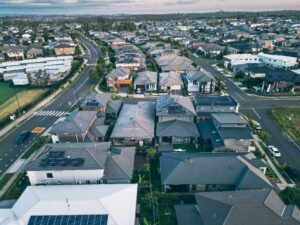Here’s how to buy US shares from Australia and 5 key factors for investors to consider

Many investors want to know how to buy US shares from Australia and we’ll seek to answer that question in this article. Investing in US shares from Australia can be a rewarding experience, as investors have exposure to a far wider range of investment opportunities, in a market that has well outperformed the ASX since the GFC.
This is not just the case with the major indices, but also individual companies. It rings particularly true in the tech sector, but it is true across the board – many blue chip companies we all know in Australia such as Coca-Cola, McDonalds and Berkshire Hathway can be bought. At the same time, it is not as straightforward as investing in Australia. And so we share not just how to buy US shares from Australia, but 6 points investors need to consider.
Here’s How to buy US shares from Australia
To buy US shares from Australia, investors typically use an online broker that offers access to US stock exchanges such as the New York Stock Exchange (NYSE) and NASDAQ. Firstly, you will need to find a brokerage that operates in Australia and supports international trading. Then, complete the registration process, which may include verifying your identity and providing financial information. Once your account is set up, you must deposit funds, often requiring a currency conversion into USD. After funding your account, you can search for the US stocks you wish to purchase and proceed to buy them through the platform.
5 points to consider when looking to buy US shares from Australia
1. Finding a broker
As noted above, you will need to find a brokerage that operates in Australia and supports international trading. Not all brokers in Australia offer this. Even those that do have several different offerings that may not meet your needs. So it is important to do your homework to find the right one.
Many investors may be attracted to the US market because some brokers offer ‘free brokerage’. You may not be getting charged a fee per trade, but you may still be getting charged in other ways you may not be aware on.
2. Tax implications
Wherever you invest in stocks, there’ll be taxes to pay. You may be liable for tax not just in Australia, but the USA too. In fact, you may need to complete IRS forms to even get started. Your broker should have advice as to how to get started, although they probably won’t be able to offer personal advice in the way a professional financial adviser would.
3. Time Zone
The US market is open 9.30am to 4pm New York time. This tends to be the middle of the night or the early morning Australian East Coast time dependant on the time of the year. So you may need to stay up late or get up early to buy or sell shares. There is some pre and post-market trading that can occur within more reasonable hours, although it may be more difficult to access.
4. America’s political, Economic and social Climate
Australian investors considering the US stock market must be acutely aware of the political and economic landscape, as these factors can significantly impact investment outcomes. Politically, the US is often characterized by its polarized environment, which can lead to volatility in markets, especially around election periods or during significant policy shifts. Economically, the Federal Reserve’s monetary policy, including interest rates and quantitative easing measures, plays a critical role in market dynamics. Granted, it can on the ASX too, but even greater in the US.
Additionally, factors such as inflation rates, unemployment figures, and GDP growth are crucial in assessing the overall health of the economy and potential market directions. Understanding these elements can help Australian investors make informed decisions when navigating the complexities of the US stock market. It’s also crucial to have a solid understanding of the US stock market’s various indices, such as the S&P 500 or NASDAQ.
5. The specific companies you’re looking at
It goes without saying that investors should research the specific companies they are interested in purchasing shares from. We also recommend investors research their industries and competitors. This will help give a better understanding of the potential risks and opportunities involved. It is important to have a diversified portfolio when investing in US shares from Australia, as this can help mitigate risk and maximize returns.
So you’ve bought your US stock, here are 5 surprises you may not have expected
1. Expect buybacks rather than dividends
So you invested in a US stock thinking you’d get even better dividends than you would from CBA? You shouldn’t have gotten your hopes up. In the US, there’s no such thing as Franking credits and so dividends are subject to double taxation (i.e. the company pays tax on its profit and the shareholder has to pay tax on money they receive even though it has already been subject to tax). With stock buybacks, only the shareholder pays tax, the company does not, and so companies prefer buybacks.
2. US stocks are more volatile than ASX 200 stocks
Yes, even larger ones. A volatile day on the ASX would be the ASX 200 moving by over 1%. In the US, it would be a movement of over 3%. This is no universal rule of thumb, but one can generally observe that US share market indices are more volatile, and so individual stocks can be, particularly larger caps that rarely have sharp intraday movements.
3. Quarterly reporting
In Australia, large caps need only produce a full set of accounts twice a year. Even non-profitable stocks that report quarterly, need only produce a cash flow statement. But all US stocks need to produce a full set of accounts quarterly.
4. There’s a deeper relationship with analysts
In the US, there are more analysts covering stocks, and the estimates they provide are more influential than in Australia. Stocks can deliver results but still fall just because they missed consensus. Moreover, there is a quarterly conference call with analysts who can really up company’s management on their toes, delivering ‘gotcha’ moments that can lead to other investors and analysts panicking.
5. Reporting EPS
Companies rarely use the word profit. They will use ‘net income’ and more commonly issue Earnings Per Share guidance.
So should you buy US shares from Australia?
If you think you can handle all these issues you wouldn’t have to handle if just investing on the ASX, it may be worth considering. As always, it might help to seek personal financial advice before making such decisions, especially if you haven’t invested overseas before.
What are the Best ASX stocks to invest in right now?
Check our buy/sell tips

Blog Categories
Get Our Top 5 ASX Stocks for FY26
Recent Posts
Diversifying Portfolios with ASX Consumer Stocks: Opportunities and Risks
The ASX 200 has delivered significant volatility recently, and market participants observing the screens in 2025 understand the turbulence firsthand.…
Is Lendlease (ASX:LLC) out of the doldrums for good?
Lendlease (ASX:LLC) has for the past several years been the classic definition of a ‘value trap’. You think a good…
Here are the 2 most important stock market taxes that investors need to be aware on
As one of two certainties in life, investors need to be aware of stock market taxes. Investors may be liable…


